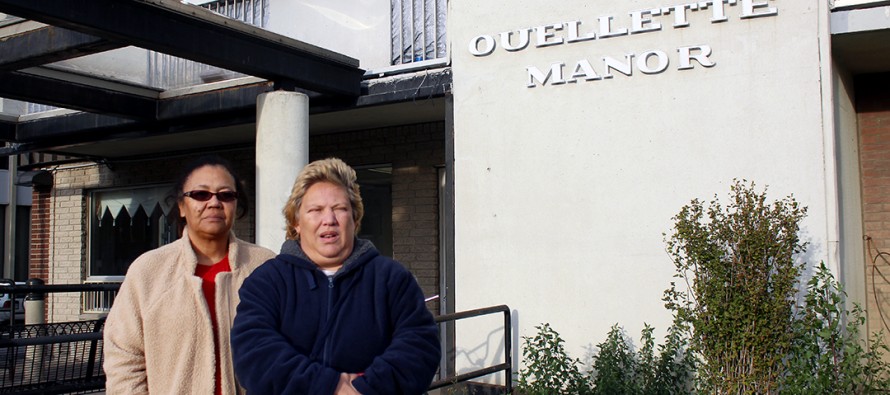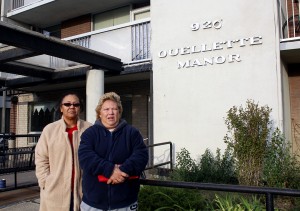Ouellette Manor pests

By Lyndi-Colleen Morgan

Dianne Darrington (left) and Bev Dupuis (right) are photographed outside 920 Ouellette Manor. Both have had sightings of cockroaches, and will be working with Orkin Canada to do their part. (Photo by Lyndi-Colleen Morgan)
Residents and staff of Ouellette Manor are waiting to see the results of the pest treatments that are underway.
Treatment of the 400 unit complex at 920 Ouellette Ave. began Nov. 3 on the 24th floor. The apartment building is owned by the Windsor-Essex Community Housing Corporation.
On Nov. 2, residents, CHC staff and Orkin Canada Pest and Termite Control held a building meeting to update residents on the status of the cockroach problem.
“Residents received written information prepared by CHC and Orkin Canada on the preparation activities needed in their own units, which was provided in multiple languages including Mandarin, Hindi and Arabic,” said Kari Schofield, the public affairs manager at CHC. CHC and the
Community University Partnership will be helping those in need, and met after the meeting to develop a framework for outside agency assistance.
Schofield said less than 25 per cent of the residents in the building attended.
“There was a lot of resistance from residents about packing all their things up. Some people are hoarders and don’t want Orkin in their house,” said Dianne Darrington, a third floor resident. “I think most of the building will cooperate with them, but there will be some who will resist.”
CHC partnered with Orkin Canada to develop a multi-faceted plan to treat the building and prevent the problem from getting out of control again.
The company will be using an aerosol treatment, residual treatment, application of a dust and vacuuming as required to remove cockroaches.
Chris Ortner is a branch manager with Orkin Canada and said an inspection will be completed before treatment.
“The treatment involves all areas of the apartment including the inspection of furniture,” said Ortner. “We are starting at the top floor and treating approximately six units per day, and we will be doing a follow up in each unit two to three weeks after treatment.”
Schofield and Ortner agreed treating a complex with multiple units the same way as a single-storey home is the best option and it has worked in the past.
Darrington said the only question from the meeting that was not answered was about a confirmed time frame for the treatments.
“I am one of the last floors to be done and they said they may not get to my room until the end of February, maybe later,” said Darrington. “I will be away from home until the middle of January or so but having to come back to the treatment is difficult.”
Darrington has concerns for residents who are going to be remaining in the building.
Those in “good health” have to stay out of their homes for four to six hours, while those with medical conditions will have to remain outside longer.
“Those with breathing problems, oxygen tanks or other medical problems will need to be out for 24 hours to make sure all the toxins are of the air before going back home,” said Darrington. “Not everyone in this building has the money to leave or stay elsewhere.”
CHC will be providing the residents who are required to leave their unit with another place to stay in the building. Regular updates will be provided to residents through informational bulletins posted in the building and and delivered directly to residents.


